Neutrosophic Sets and Systems, Vol. 50, 2022 University of New Mexico
Introduction to Neutrosophic Restricted SuperHyperGraphs and Neutrosophic Restricted SuperHyperTrees and several of their properties
Masoud Ghods1,*, Zahra Rostami 2, Florentin Smarandache3
1Department of Mathematics, Semnan University, Semnan 35131-19111, Iran, mghods@semnan.ac.ir
2Department of Mathematics, Semnan University, Semnan 35131-19111, Iran, zahrarostami.98@semnan.ac.ir
3University of New Mexico, 705 Gurley Ave., Gallup Campus, New Mexico 87301, United States, smarand@unm.edu
* Correspondence: mghods@semnan.ac.ir; Tel.: (09122310288)
Abstract: In this article, we first provide a modified definition of SuperHyperGraphs (SHG) and we call it Restricted SuperHyperGraphs (R-SHG). We then generalize the R-SHG to the neutrosophic graphs and then define the corresponding trees. In the following, we examine the Helly property for subtrees of SuperHyperGraphs
Keywords: SuperHyperGraphs; Restricted SuperHyperGraphs; Neutrosophic SuperHyperGraphs; Neutrosophic SuperHyperTrees; Helly property; chordal graph; subtree
1. Introduction
Hypergraph theory is one of the most widely used theories in modeling large and complex problems. In recent years, many efforts have been made to find different properties of these graphs [15]. One of these features that is also very important is the property of Helly. To read more about this property, you can refer to [4, 5]. Here we first rewrite the definition of SuperHyperGraphs from [1], which has the advantage that we have reduced the empty set from the set of vertices because in practice the empty vertex is not much applicable, and we have also categorized the set of vertices and edges according to its type. Then the adjacency matrix. We define the incidence matrix and the Laplacian matrix.
Obviously, if a super hyper power graph contains a triangle, it will not have a highlight feature. We show here that some defined super hyper power graphs have subtrees that have Helly property. There are algorithms for detecting Helly property in subtrees that the reader can refer to [4] to view. In graph theory, a chordal graph is a graph in which each cycle is four or more lengths and contains at least one chord. In other words, each induction cycle in these graphs has a maximum of three vertices. Chord graphs have unique features and applications. To study an example of the applications of chordal graphs, you can refer to [7].
Definition 1 [4]. Let �� be a set. We say that �� has Helly property if and only if, for every non-empty set �� such that �� ⊆�� and for all sets ��,�� such that ��,�� ∈�� holds �� meets �� holds ∩�� ≠∅
Proposition 1 [4]. Let �� be a tree and �� be a finite set such that for every set �� such that �� ∈�� there exists a subtree �� of �� such that �� is equal the vertices of �� Then �� has Helly property.
M. Ghods, Z. Rostami, F. Smarandache. Introduction to Neutrosophic Restricted SuperHyperGraphs and Neutrosophic Restricted SuperHyperGraphsTrees and several of their propertiesNeutrosophic Sets and Systems, Vol. 50, 2022 481
2. NeutrosophicRestrictedSuperHyperGraphs
In this section, we provide a modified definition of Restricted SuperHyperGraphs (RSHG), and then generalize this definition to neutrosophic graphs
Definition2.SuperHyperGraph (����G))[1]
A Super Hyper Graph (������) is an ordered pair ������ =(�� ⊆��(��)\∅,�� ⊆��(��)×��(��)), where
i. �� ={��1,��2, ,����} is a finite set of ��≥0 vertices, or an infinite set.
ii. ��(��) is the power set of �� (all subset of ��). therefore, an ������-vertex may be a single (classical) vertex (������), or a supervertex (������) (a subset of many vertices) that represents a group (organization), or even an indeterminate-vertex (����) (unclear, unknown vertex);
iii. �� ={��1,��2, ,����}, for �� ≥1, is a family of subsets of ��×��, and each ���� is an ������ edge, ���� ∈��(��)×��(��). An ������ edge may be a (classical) edge, or a super-edge (edge between super vertices) that represents connections between two groups (organizations), or hyper-super-edge that represents connections between three or more groups (organizations), or even an indeterminate-edge (unclear, unknown edge); ∅ represents the null-edge (edge that means there is no connection between the given vertices).
Definition2-1(2-RestrictedSuperHyperGraphs)
2-Restricted SuperHyperGraphs are a special case of SuperHyperGraphs, where we look at the system from the part to the whole. So, according to definition 2, we have
1. Single Edges (������), as in classical graphs.
2. Hyper Edges (����), edges connecting three or more single- vertices.
3. Super Edges (������), edges connecting only two ������- vertices and at least one vertex is super Vertex.
4. Hyper Super Edges (������), edges connecting three or more single- vertices (and at least one vertex is super vertex.
5. Indeterminate Edges (����), either we do not know their value, or we do not know what vertices they might connect.
Then, �� =(��,��) where �� =(������,������,����)⊆��(��)\∅, and �� =(������,����,������,������,����)⊆��(��)×��(��)
Definition 3 (Neutrosophic Restricted SuperHyperGraphs) Let �� =(��,��) be a Restricted SuperHyperGraph. If all vertices and edges of �� belong to the neutrosophic set, then the SHG is a Neutrosophic Restricted SuperHyperGraphs (NRSHG) If �� is a neutrosophic super vertex containing vertices {��1,��2, ,����}, where ���� ∈�� for 1≤�� ≤��, then ����(��)=min{����(����),1≤�� ≤��}, ����(��)=min{����(����),1≤�� ≤��}, ����(��)=max{����(����),1≤�� ≤��}
Definition 4. Let �� =(��,��) be a 2-Restricted SuperHyperGraph, with �� =(������,������,����)⊆��(��)\∅, and �� =(������,����,������,������,����)⊆ ��(��)×��(��). Then, the adjacency matrix ��(��)=(������) of �� is defined as a square matrix which columns and rows its, is shown by the vertices of �� and for each ����,���� ∈��, ������ = {
0 thereshouldbenoedgebetweenvertices���� and����; 1 thereisasingleedgebetweenvertices���� and����; S thereisasuperedgebetweenvertices���� and����; H thereisahyperedgebetweenvertices���� and����; SH thereisasuperhyperedgebetweenvertices���� and����
Note that in the adjacency matrix ��, a value of one can be placed instead of non-numeric values (��, �� and ����) if necessary for calculations. So that, since �� is a symmetric and values of �� is positive, eigenvalues of �� are real.
Definition5 Let �� =(��,��) be a Restricted SuperHyperGraph, with �� =(������,������,����)⊆��(��)\∅, and �� =(������,����,������,������,����)⊆��(��)× ��(��). If �� =(��1,��2, ,����) then an incidence matrix ��(��)=(������) define as
M. Ghods, Z. Rostami, F. Smarandache. Introduction to Neutrosophic Restricted SuperHyperGraphs and Neutrosophic Restricted SuperHyperGraphsTrees and several of their properties
Neutrosophic Sets and Systems, Vol. 50, 2022 482
������ ={1 �������� ∈����, 0 ����ℎ������������.
Definition6 Let �� =(��,��) be a Restricted SuperHyperGraph, with �� =(������,������,����)⊆��(��)\∅, and �� =(������,����,������,������,����)⊆��(��)× ��(��). If �� =��������(��(��1),��(��2),…,��(����)) where ��(����)=∑ ���������� ����∈�� , then, a laplacian matrix define as ��(��)=�� ��(��)
Example 1. Consider �� =(��,��) as shown in figure 1 (This figure is selected from reference [1]) Where �� = {��1,��2,��3,��4,��5,��6,��7,��8,����9,����45,����1,2,3} and �� ={������5,6,����7,8,����123,45,����459,3,������123,7,8} We now obtain the SuperHyperGraph –related matrices in figure 1 using the above definitions.
a. Adjacency matrix
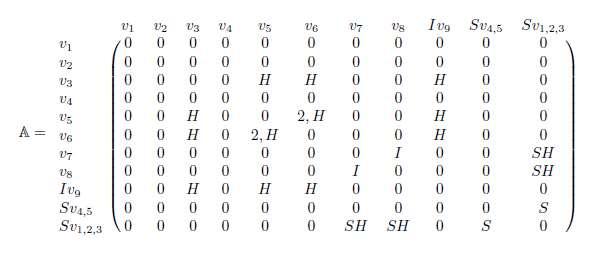
Figure 1. a Restricted SuperHyperGraph�� =(��,��)
M. Ghods, Z. Rostami, F. Smarandache. Introduction to Neutrosophic Restricted SuperHyperGraphs and Neutrosophic Restricted SuperHyperGraphsTrees and several of their properties
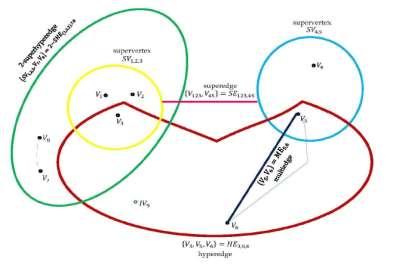
b. incidence matrix

c. Laplacian matrix
To calculate the Laplacian matrix, we first obtain the diameter matrix ��, in which the vertices on the principal diameter, the degree of vertices, and the other vertices are 0. Then its Laplacian matrix is calculated as follows.
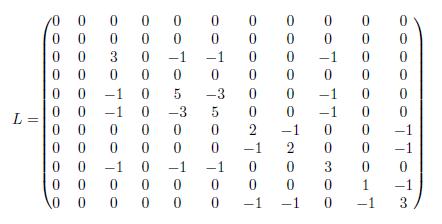
3. Neutrosophic SuperHyperTree
In this section, we first provide a definition of Neutrosophic SuperHyperTree. We then define the subtree for Neutrosophic SuperHyperGraphs. In the following, we will examine the Helly property in this type of power graphs.
Definition 7. Let �� =(��,��) be a Neutrosophic SuperHyperGraph. Then �� is called a Neutrosophic SuperHyperTree (NSHG) if �� be a connected Neutrosophic SuperHyperGraph without a neutrosophic cycle.
Definition 8. Let �� =(��,��) be a Neutrosophic SuperHyperGraph. Then �� is called a subtree NSHG if there exists a tree �� with the same vertex set �� such that each hyperedge, superedge, or hypersuperedge �� ∈�� induces a subtree in �� Note. Here we consider the underlying graph ��∗ to find the subtree of NSHG.
Neutrosophic Sets and Systems, Vol. 50, 2022
Example 2. Consider �� =(��,��) a Restricted SuperHyperGraph as shown in figure 2.
Figure 2. A Restricted SuperHyperGraph
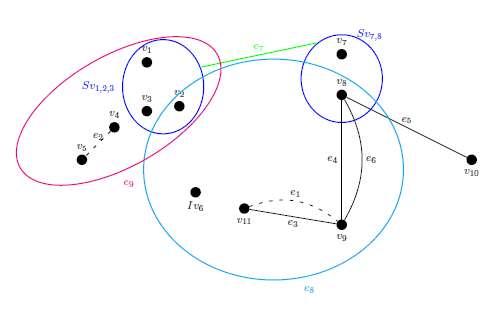
As you can see, since �� contains the cycle, so that �� is not a Restricted SuperHyperTree An ������ subgraph induced by the subset {��7,��8,��9,��5} of ��, is a RSHT.
Example 3 Consider �� =(��,��) a Neutrosophic Super Hyper Power Graph as shown in figure 3 Note that in this example all vertices and edges belong to the neutrosophic sets. As you can see, G is a Restricted SuperHyperTree.
Figure 3. A Neutrosophic Restricted SuperHyperTree ��
Now we find a subtree according to definition 7 for ��.
Figure 4. A subtree for NRSHG ��
Now, let �� =(��,��) be a tree, that is, �� is a connected neutrosophic graph without cycle. Then, we build a connected NRSHGraph �� in the following way:
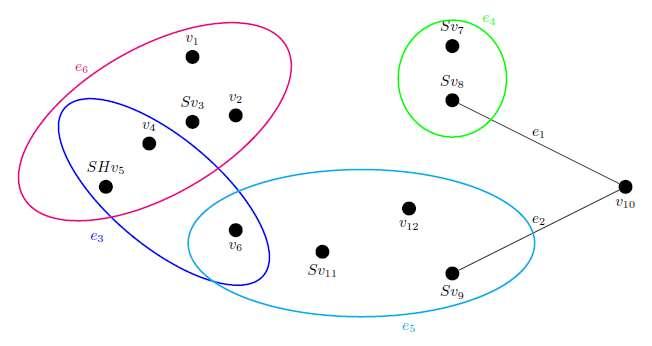
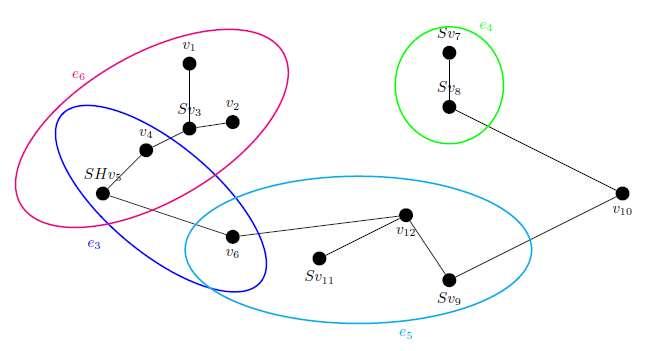
Neutrosophic Sets and Systems, Vol. 50, 2022 486
1. The set of vertices of �� is the set of vertices of ��; 2. The set of edges (hyperedges, superedges or superhyperedges) are a family E of subset V such that induced subgraph ���� is a subtree of T where ���� is produced by vertices located on edge ���� ∈��. so that subgraph ���� is a tree.
Theorem 1. Let �� =(��,��′) be a tree. Also, �� is a subtree Restricted SuperHyperGraph according to ��. Then �� has the Helly property.
Proof. Since for each tree there exist exactly one path between the two vertices ����,����. The path between two vertices ����,���� denoted ��[����,����].suppose that, ����,���� and ���� are three vertices of �� The paths ��[����,����], ��[����,����] and ��[����,����] have one common vertex. Now, using theorem 1, for each family of edges (hyperedges, superedges and superhyperedges) where the edge contains at least two of the vertices ����,���� and ���� have a non-empty intersection.
Theorem 2. Let �� =(��,��′) be a tree. Also, �� is a subtree Restricted SuperHyperGraph according to ��. Then ��(��) is a chordal graph.
Proof. Consider �� =(��,��′) is a tree. Suppose �� is a subtree Restricted SuperHyperGraph according to T. If |��|=1, then �� include exactly one vertex and one hyperdege, so that, the linegraph of H has only one vertex hence H is a clique It turns out that �� is a chordal graph. Next, assume that the assertion is true for each tree with |��|=�� 1,�� >1 Now we have to show that the problem assumption is valid for �� vertices as well. For that, suppose �� ∈�� is a vertex leaf on ��. remember that in a tree with at least two vertices there exist at least two leaves. If ��1 =(�� {��},��1 ′), where ��1 is the subgraph on �� {��}, and ��1(�� {��})=(�� {��},��1), |��|>1
The ��1 =(�� {��},��1 ′) is a tree moreover ��1 =(�� {��},��1) is an induced subtree Restricted SuperHyperGraph associated with ��1. Hence ��(��1) is chordal. Now, if the number of edges should be the same, that is, |��′|=|��1 ′| then we have ��(��)≈��(��1) so that ��(��) is a chordal graph. If |��′|≠|��1 ′| then we have {��}∈��′ ������|��′|>|��1 ′|
It is easy to show that a neighborhood from {��} in ��(��) is a clique. Hence any cycle passing through {v} is chordal in ��(��) and so ��(��) is chordal.
Corollary 1 A Restricted SuperHyperGraph �� is a subtr Restricted SuperHyperGraph if and only if �� has the Helly property and its line graph is a chordal graph.
4. Conclusions
In this article, we have defined a SuperHyperTree and Neutrosophic SuperHyperTree, and examined the Helly property, which is one of the most important and practical properties in subtrees,
M. Ghods, Z. Rostami, F. Smarandache. Introduction to Neutrosophic Restricted SuperHyperGraphs and Neutrosophic Restricted SuperHyperGraphsTrees and several of their propertiesNeutrosophic Sets and Systems, Vol. 50, 2022 487
for the super hyper tree introduced in this article. There are also algorithms for detecting Helly property that we have omitted here.
References
1. Smarandache, F. Extension of HyperGraph to n-SuperHyperGraph and to Plithogenic nSuperHyperGraph, and Extension of HyperAlgebra to n-ary (Classical-/Neutro-/Anti)HyperAlgebra. 2020. Neutrosophic Sets and Systems, Vol. 33.
2. Smarandache, F. n-SuperHyperGraph and Plithogenic n-SuperHyperGraph. 2019. in Nidus Idearum, Vol. 7, second edition, Pons asbl, Bruxelles, pp. 107-113.
3. Smarandache, F. The neutrosophic triplet (n-ary HyperAlgebra, n-ary NeutroHyperAlgebra, n-ary AntiHyper Algebra). 2019. In Nidus Idearum, Vol. 7, second edition, Pons asbl, Bruxelles, pp. 104-106.
4. Bretton, A., Ubeda, S., Zerovnik, Y. A polynomial algorithm for the strong Helly property. 2002. IPL. Inf. Process. Lett. 81(1), 55-57.
5. Voloshin, V.I. Introduction to Graph and Hypergraph Theory. 2009. Nova Science Publishers, New York.
6. Enright, J., Rudnicki, P. Helly Property for Subtrees. 2008. FORMALIZED MATHEMATICS, Vol 16, pp. 91-96.
7. Agnarsson, G. On Chordal Graphs and Their Chromatic Polynomials. 2003. Math SCAND. 93(2), pp, 240-246. Dio:10.7146/math.scand.a-14421, MR 2009583.
Received: Feb 8, 2022. Accepted: Jun 14, 2022
M. Ghods, Z. Rostami, F. Smarandache. Introduction to Neutrosophic Restricted SuperHyperGraphs and Neutrosophic Restricted SuperHyperGraphsTrees and several of their properties
